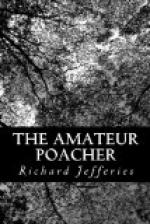It is commonly said that in climbing it is best to look up—a maxim that has been used for moral illustrations; but it is a mistake. In ascending a tree you should never look higher than the brim of your hat, unless when quite still and resting on a branch; temporary blindness would be the penalty in this case. Particles of decayed bark, the borings of insects in dead wood, dust, and fragments of twigs, rush down in little streams and fill the eyes. The quantity of woody powder that adheres to a tree is surprising; every motion dislodges it from a thousand minute crevices. As for firs, in climbing a fir one cannot look up at all—dead sticks, needles, and dust pour down, and the branches are so thick together that the head has to be forced through them. The line fixed, the saw is applied, and by slow degrees the butt cut nearly through. Unless much overbalanced on one side by the limbs, an oak will stand on a still day when almost off.
Some now seize the rope, and alternately pull and slacken, which gives the tree a tottering movement. One more daring than the rest drives a wedge into the saw-cut as it opens when the tree sways. It sways—it staggers; a loud crack as the fibres part, then with a slow heave over it goes, and, descending, twists upon the base. The vast limbs plough into the sward; the twigs are crushed; the boughs, after striking the earth, rebound and swish upwards. See that you stand clear, for the least branch will thresh you down. The flat surface of the exposed butt is blue with stains from the steel of the saw.
Light taps with a small sharp axe, that cut the rind but no deeper, ring the trunk at intervals. Then the barking irons are inserted; they are rods of iron forged at the top something like a narrow shallow spoon. The bark from the trunk comes off in huge semi-cylinders almost large enough for a canoe. But that from the branches is best. You may mark how at the base the bark is two inches thick, lessening to a few lines on the topmost boughs. If it sticks a little, hammer it with the iron: it peels with a peculiar sound, and the juicy sap glistens white between. It is this that, drying in the sun, gives the barked tree its colour: in time the wood bleaches paler, and after a winter becomes grey. Inside, the bark is white streaked with brown; presently it will be all brown. While some strip it, others collect the pieces, and with them build toy-like sheds of bark, which is the manner of stacking it.
From the peeled tree there rises a sweet odour of sap: the green mead, the green underwood and hawthorn around, are all lit up with the genial sunbeams. The beautiful wind-anemones are gone, too tender and lovely for so rude an earth; but the wild hyacinths droop their blue bells under the wood, and the cowslips rise in the grass. The nightingale sings without ceasing; the soft ‘coo-coo’ of the dove sounds hard by; the merry cuckoo calls as he flies from elm to elm; the wood-pigeons rise and smite their wings together over the firs. In the mere below the coots are at play; they chase each other along the surface of the water and indulge in wild evolutions. Everything is happy. As the plough-boys stroll along they pluck the young succulent hawthorn leaves and nibble them.




